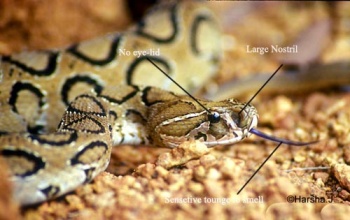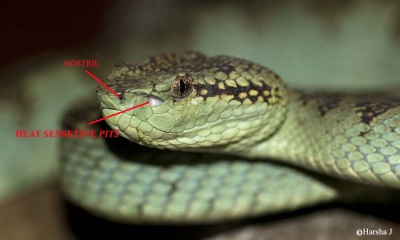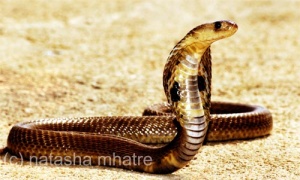Snakes are COLD BLOODED legless reptiles, closely related to lizards, which share the order Squamata. There is also one species of LEGLESS LIZARD which superficially resemble snakes, but are not otherwise related to them. A love of snakes is called ophiophilia, a fear of snakes is called ophidiophobia (or snakephobia), a specialist in snakes is an ophiologist.
There are over 270 species of snakes in India out of which about 60 are venomous. In size, color and habits they can be very different from each other.
| |
Snake Senses
Snakes have good vision especially KING COBRA and the tree snakes, but most of them are near-sighted like borrowing snakes and the others. Of course, all are colour-blind. They do not have eye-lid to cover their eye.
Snakes can smell pretty well mainly by their sensitive tongue,but not much by their nostrils. The tongue picks up the odours/molecules in the air and the Jacobson's organ above the mouth will make out what the odour is.
Snakes like Pythons & Pit Vipers have heat sensing pits, which helps in detect warm-blooded animals like rodents & birds in absolute darkness.
Venomous Snakes
Venom is a prey-immobilizing substance in snakes that is used secondarily as a defense system. Venom is not composed of a single substance, but is a toxic saliva consisting of a complex mixture of chemicals called enzymes. Almost all venoms are composed of approximately 90% proteins. Two general types of toxins are known, neurotoxins and hemotoxins.
- Hemotoxin (blood toxin) : Hemotoxic venom attacks the circulatory system and muscle tissue causing excessive scarring, gangrene, and sometimes leads to amputation of the affected area. This venom basically destroys tissue and blood cells. In addition to killing the prey, part of the function of a hemotoxic venom for some animals is to aid digestion. The venom breaks down protein in the region of the bite, making prey easier to digest.ex : VIPERS
- Neurotoxin (nerve toxin) : Neurotoxic venom attacks the victim's central nervous system and usually result in heart failure and/or breathing difficulties or even total respiratory paralysis. eg: COBRAS, KRAITS, CORAL SNAKES.
Some snakes have venom that is both hemotoxic and neurotoxic.
Snakes Classification
Water Snakes
As their name suggests, watersnakes spend most of their time in water. They eat frogs and fish. None of the Indian freshwater snakes are venomous however sea snakes are very venomous. Some fresh water snakes have mild venom to help them catch their prey. But the venom is not harmful to man.
Watersnakes are average-sized snakes: not too thin and not too fat. They do not move fast on land like tree snakes but take their time getting around. Once in the water, however, they are strong, swift swimmers.
- KEELBACK and Olive Keelback
- DOG FACED WATER SNAKE
Land Sankes
- RAT SNAKE
- PYTHON
- COBRAS
Burrowing Snakes
Burrowing snakes live underground. Of course, there are also other snakes that go underground to escape the heat of the sun and to hide from predators. But burrower’s are the only ones that can dig their own holes. The other has to depend on the holes made by crabs, rats and termites. The burrowing snake’s skull is as powerful as the point of a crowbar. Its stocky body and strong neck muscles make it easy for the snake to bulldoze its way through soft soil. The species from the hills are so dependent on remaining cool that they often die in a human hand (Which usually has a temperature of about 37º C).
There are three groups of burrowing snakes in India:
- Small WORM SNAKES (often mistaken for worms)
- SHEILDTAILS or uropeltids
- SAND BOAS







No comments:
Post a Comment